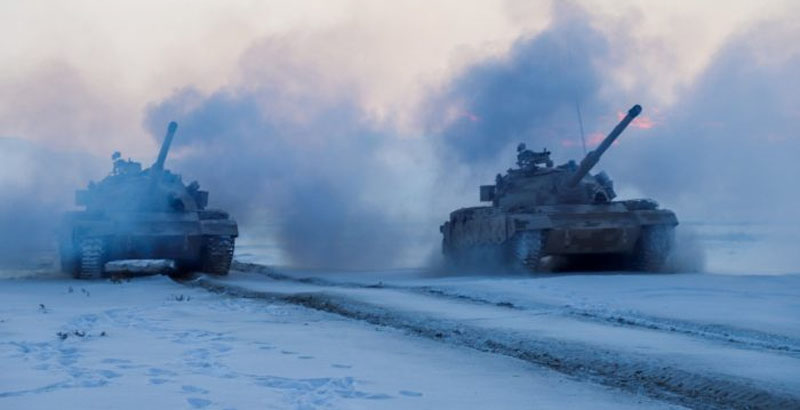To Check-Mate China In Border Conflict Indian Army Needs Innovation, Not Imitation – Experts
May 1, 2021
As the Indian Army plans to procure lightweight tanks in view of the protracted border conflict with China, experts are examining whether this is a knee-jerk reaction or it has long-term benefits.
Last week, The EurAsian Times reported that the Indian Army has issued a Request for Information (RFI) to acquire 350 indigenous light tanks that can easily maneuver at high-altitude battlefields and rival the much-publicized Chinese T-15 tanks.
After China swiftly deployed T-15 tanks and later VT-4 during the Ladakh standoff last year, New Delhi gave the green light to the emergency procurement of lightweight tanks. This led to a debate within India’s defense circles on whether to import light tanks for quick use or to develop indigenous products.
One option that was looked at was the Russian 18-ton amphibious ‘Sprut-SD’ with its 125mm gun. A major advantage was its commonality of ammunition with the army’s existing T-90 and T-72 tanks which are also of Russian origin.
Others had questioned whether India would choose domestic means and either approve already pitched DRDO plans to modify BMP-1 (an infantry fighting vehicle) or combine the K9 ‘Vajra’ 155 mm self-propelled howitzer with DRDO designs. In the end, India decided to focus on its ‘Make in India’ scheme but with fresher proposals.
These developments have led to various expert opinions within the defense sector which recommend far-sighted policies.
Innovation Is The Key
Rather than a stand-alone light tank, the Army should go for a multi-purpose combat platform, Lt Gen H S Panag (Retd) wrote in ThePrint. This platform could have two basic variants — light tank and Infantry Carrier Vehicle (ICV)/Armoured Personnel Carrier (APC), and additional configurations for multiple combat/combat support tasks.
The American Stryker eight-wheeled armored vehicle, with its family of ten different vehicles on a common chassis, can be used as a model.
Lt Gen Panang also supports reforms in the current system of traditional divisions/brigades which he criticizes as inefficient and outdated. Combined Arms Battle Groups (CABG) can be used as the new system of formation in eastern Ladakh. Such a formation can combine an efficient proportion of infantry battalion and mechanized brigade.
In this restructured model, the light tanks will be integrated and augmented with medium tanks due to the varying terrain of Ladakh.
While the former has agility in passes (such as Rezang La and Rechin La) and the ridge line (such as Kailash Range) and is more suited for high altitude combat and amphibious operations (such as in Pangong Tso), the latter is befitted for the broader valleys and plateaus (such as the Chushul bowel, Tibetan plateau and Depsang Plains).
The narrow focus on Ladakh has been questioned by Lt General K. J. Singh (Retd) who pointed out the need for adaptability in any situation, preferably through a versatile weapon. His idea of a modular approach to set up a common chassis while mounting different variants on top, according to terrain and role echoes Panag’s words.
As light tanks cannot carry troops, combat support and air defense through Infantry Combat Vehicles will need to be grouped together with light tanks, according to Major General Birender Dhanoa (Retd).
Additionally, we do need to figure out if light tanks are going to be applicable in the future battlefield that may or may not match what the establishment has in mind when they firm in the light tank requirement,” Dhanoa told ThePrint.
All these opinions show that India should not have immediate knee-jerk reactions to the present situation but far-sighted planning which takes into account future circumstances.
India should probably not fixate on getting what China has but think of ways to find the chinks in its armor or advanced technology which can complete out-do any adversary.
Nitin J Ticku a strategic analyst told the EurAsian Times – look at Turkey and what their drones did during the Armenia-Azerbaijan war. Even with the best of Russian-origin tanks and armored vehicles, the Armenians had no answer to Turkish Bayraktar tb2 drones that devastated their defenses.
Even if we look at the Soviet invasion of Afghanistan, the Americans equipped the Taliban with innovative stinger missiles to counter the then super-power – USSR and surprisingly Soviets had no answer to the US-origin missiles which eventually led to their withdrawal.
Innovation is the key, rather than imitating the opponents. If India wants to check-mate China in the border conflict, New Delhi needs to innovate instead of merely match tank for a tank, Ticku concluded.
Courtesy: The Eurasian Times

